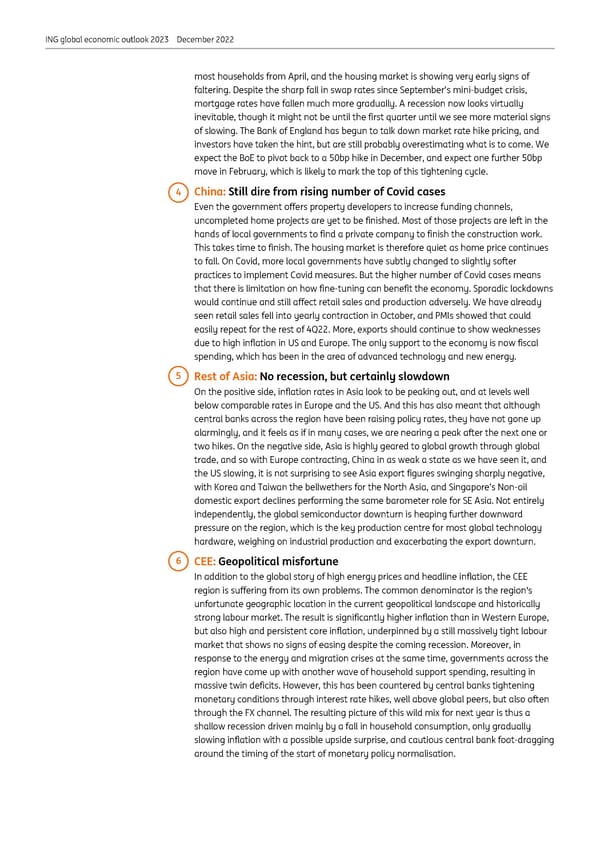ING global economic outlook 2023 December 2022 most households from April, and the housing market is showing very early signs of faltering. Despite the sharp fall in swap rates since September’s mini-budget crisis, mortgage rates have fallen much more gradually. A recession now looks virtually inevitable, though it might not be until the first quarter until we see more material signs of slowing. The Bank of England has begun to talk down market rate hike pricing, and investors have taken the hint, but are still probably overestimating what is to come. We expect the BoE to pivot back to a 50bp hike in December, and expect one further 50bp move in February, which is likely to mark the top of this tightening cycle. 4 China: Still dire from rising number of Covid cases Even the government offers property developers to increase funding channels, uncompleted home projects are yet to be finished. Most of those projects are left in the hands of local governments to find a private company to finish the construction work. This takes time to finish. The housing market is therefore quiet as home price continues to fall. On Covid, more local governments have subtly changed to slightly softer practices to implement Covid measures. But the higher number of Covid cases means that there is limitation on how fine-tuning can benefit the economy. Sporadic lockdowns would continue and still affect retail sales and production adversely. We have already seen retail sales fell into yearly contraction in October, and PMIs showed that could easily repeat for the rest of 4Q22. More, exports should continue to show weaknesses due to high inflation in US and Europe. The only support to the economy is now fiscal spending, which has been in the area of advanced technology and new energy. 5 Rest of Asia: No recession, but certainly slowdown On the positive side, inflation rates in Asia look to be peaking out, and at levels well below comparable rates in Europe and the US. And this has also meant that although central banks across the region have been raising policy rates, they have not gone up alarmingly, and it feels as if in many cases, we are nearing a peak after the next one or two hikes. On the negative side, Asia is highly geared to global growth through global trade, and so with Europe contracting, China in as weak a state as we have seen it, and the US slowing, it is not surprising to see Asia export figures swinging sharply negative, with Korea and Taiwan the bellwethers for the North Asia, and Singapore’s Non-oil domestic export declines performing the same barometer role for SE Asia. Not entirely independently, the global semiconductor downturn is heaping further downward pressure on the region, which is the key production centre for most global technology hardware, weighing on industrial production and exacerbating the export downturn. 6 CEE: Geopolitical misfortune In addition to the global story of high energy prices and headline inflation, the CEE region is suffering from its own problems. The common denominator is the region's unfortunate geographic location in the current geopolitical landscape and historically strong labour market. The result is significantly higher inflation than in Western Europe, but also high and persistent core inflation, underpinned by a still massively tight labour market that shows no signs of easing despite the coming recession. Moreover, in response to the energy and migration crises at the same time, governments across the region have come up with another wave of household support spending, resulting in massive twin deficits. However, this has been countered by central banks tightening monetary conditions through interest rate hikes, well above global peers, but also often through the FX channel. The resulting picture of this wild mix for next year is thus a shallow recession driven mainly by a fall in household consumption, only gradually slowing inflation with a possible upside surprise, and cautious central bank foot-dragging around the timing of the start of monetary policy normalisation.
 ING Global Economic Outlook 2023 Page 4 Page 6
ING Global Economic Outlook 2023 Page 4 Page 6